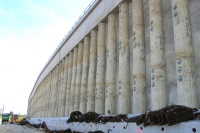Vienna - Salzburg High-Performance
Railway Line, Asten - Linz Section
Client: Austrian Railways Infrastructure Construction AG
Development Period: 1998 bis 2009
The 7.8 km long, Asten - Linz high-performance railway section, required the addition of two tracks. Among others, the construction of the following was necessary:
- 2 new railway stations
- 3 new or reconstructed railway stops
- 5 pedestrian tunnels, 3 brook bridges
- 3 new bridges across the Traun River
- 2 railway overpasses
- 9 road or tram underpasses
- 16 retaining walls
Along the whole section, the new tracks run parallel and in close vicinity to the existing Western Railway Line. Consequently, all the work had to be done in consideration of the traffic and in multiple construction phases. This required numerous securing measures of building pits, parallel to the tracks. Near the railway overpasses, up to six tracks already existed of which only one could be taken out of service at any given time.
BGG Consult was commissioned as the geotechnical and geohydrological consultant for both the planning and construction phases. A subsoil exploration campaign was conducted and enquiries were made both on the site and with the authorities. The results of these examinations were used to compile geotechnical and geohydrological expert's reports required for the application of the construction permit, and subsequently for the tender procedure.
During construction, BGG Consult was responsible, for example, to dimension, verify and examine on site, numerous securing measures for the building pits.
Furthermore, geotechnical measurements were planned and supervised or carried out. Finally, the geological documentation and the hydrogeological preservation of evidence were conducted.
Bored pile wall AL150:
In order to make room for the straightening of the track, Mount Schilten had to be cut back. This required a retaining structure, with a height of 14 m, directly besides the B1 federal road. A bored pile wall design, anchored at three levels was developed in close cooperation with the planner. The bored piles (Ø 120 cm) were spaced 2.4 m apart and the spaces between the piles were secured with shotcrete. Up to three anchors were necessary for each anchoring level.
Due to the accurate assessment of the underground situation, the professional geological documentation during construction, and the geotechnical surveillance (by means of inclinometers and geodetic measuring points), the construction was completed without major problems.
November 2009
